Analyzing Change Management at NEMC Using Change Path Model
VerifiedAdded on 2023/04/25
|21
|5229
|192
Case Study
AI Summary
This case study delves into the organizational change management strategies employed at New England Medical Center (NEMC), focusing on its transformation from a financially struggling institution to a stable healthcare provider. The analysis incorporates theoretical frameworks such as Duck's five-stage change curve and the Change Path Model to evaluate the effectiveness of the implemented changes. It highlights the challenges faced by NEMC, including financial constraints and market competition, and examines the leadership approach of Zane in navigating these challenges. The study assesses the strategic alliances, cost-cutting initiatives, and restructuring plans undertaken to improve operational efficiency and quality of healthcare services. Furthermore, it provides recommendations for enhancing change management processes, emphasizing the importance of employee engagement, communication, and continuous improvement to ensure sustainable organizational success. This document is available on Desklib, a platform offering a wide range of study resources for students.

Running head- MANAGEMENT
Organizational change management
Name of the student
Name of the university
Author note
Organizational change management
Name of the student
Name of the university
Author note
Paraphrase This Document
Need a fresh take? Get an instant paraphrase of this document with our AI Paraphraser
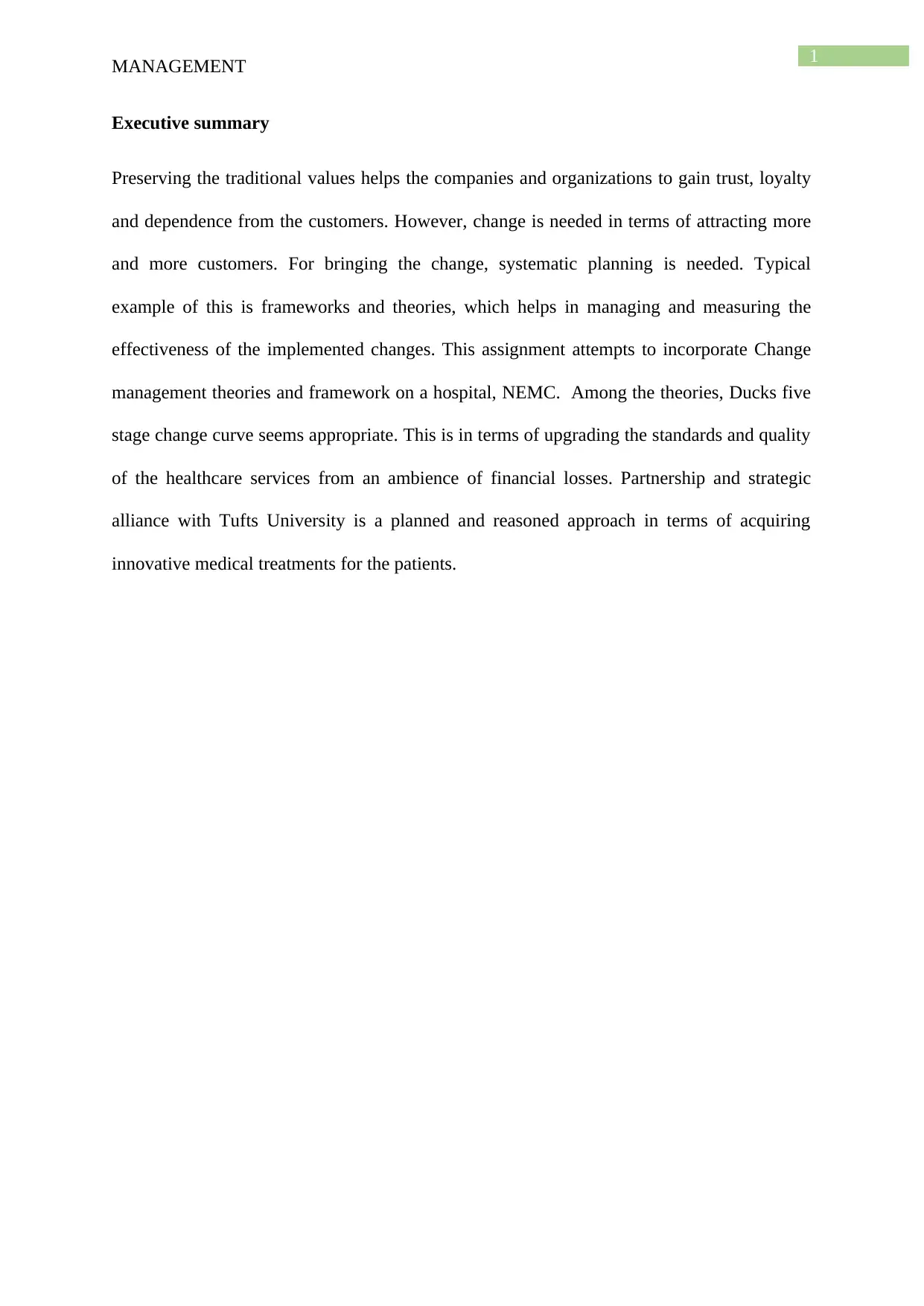
1
MANAGEMENT
Executive summary
Preserving the traditional values helps the companies and organizations to gain trust, loyalty
and dependence from the customers. However, change is needed in terms of attracting more
and more customers. For bringing the change, systematic planning is needed. Typical
example of this is frameworks and theories, which helps in managing and measuring the
effectiveness of the implemented changes. This assignment attempts to incorporate Change
management theories and framework on a hospital, NEMC. Among the theories, Ducks five
stage change curve seems appropriate. This is in terms of upgrading the standards and quality
of the healthcare services from an ambience of financial losses. Partnership and strategic
alliance with Tufts University is a planned and reasoned approach in terms of acquiring
innovative medical treatments for the patients.
MANAGEMENT
Executive summary
Preserving the traditional values helps the companies and organizations to gain trust, loyalty
and dependence from the customers. However, change is needed in terms of attracting more
and more customers. For bringing the change, systematic planning is needed. Typical
example of this is frameworks and theories, which helps in managing and measuring the
effectiveness of the implemented changes. This assignment attempts to incorporate Change
management theories and framework on a hospital, NEMC. Among the theories, Ducks five
stage change curve seems appropriate. This is in terms of upgrading the standards and quality
of the healthcare services from an ambience of financial losses. Partnership and strategic
alliance with Tufts University is a planned and reasoned approach in terms of acquiring
innovative medical treatments for the patients.
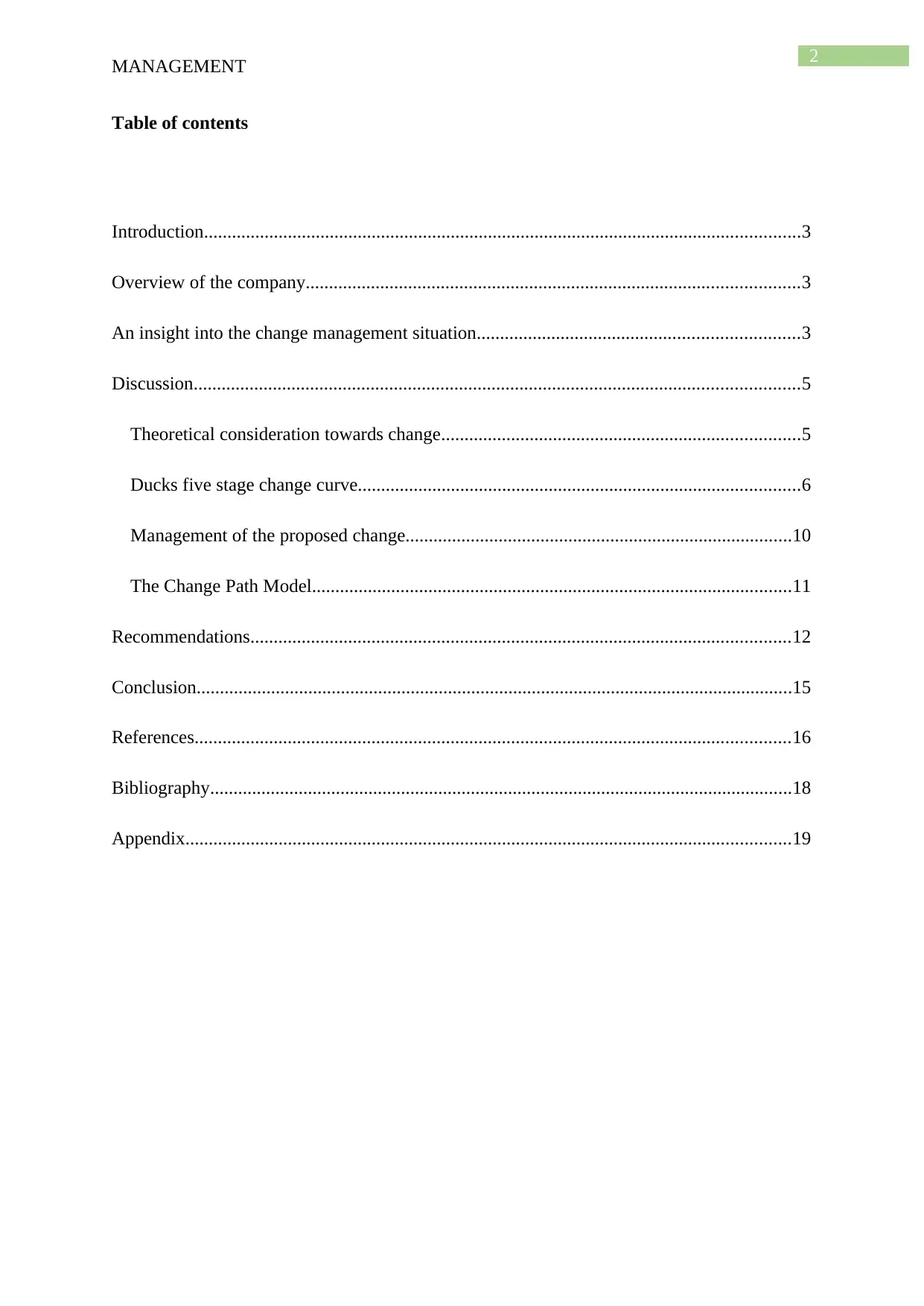
2
MANAGEMENT
Table of contents
Introduction................................................................................................................................3
Overview of the company..........................................................................................................3
An insight into the change management situation.....................................................................3
Discussion..................................................................................................................................5
Theoretical consideration towards change.............................................................................5
Ducks five stage change curve...............................................................................................6
Management of the proposed change...................................................................................10
The Change Path Model.......................................................................................................11
Recommendations....................................................................................................................12
Conclusion................................................................................................................................15
References................................................................................................................................16
Bibliography.............................................................................................................................18
Appendix..................................................................................................................................19
MANAGEMENT
Table of contents
Introduction................................................................................................................................3
Overview of the company..........................................................................................................3
An insight into the change management situation.....................................................................3
Discussion..................................................................................................................................5
Theoretical consideration towards change.............................................................................5
Ducks five stage change curve...............................................................................................6
Management of the proposed change...................................................................................10
The Change Path Model.......................................................................................................11
Recommendations....................................................................................................................12
Conclusion................................................................................................................................15
References................................................................................................................................16
Bibliography.............................................................................................................................18
Appendix..................................................................................................................................19
⊘ This is a preview!⊘
Do you want full access?
Subscribe today to unlock all pages.

Trusted by 1+ million students worldwide
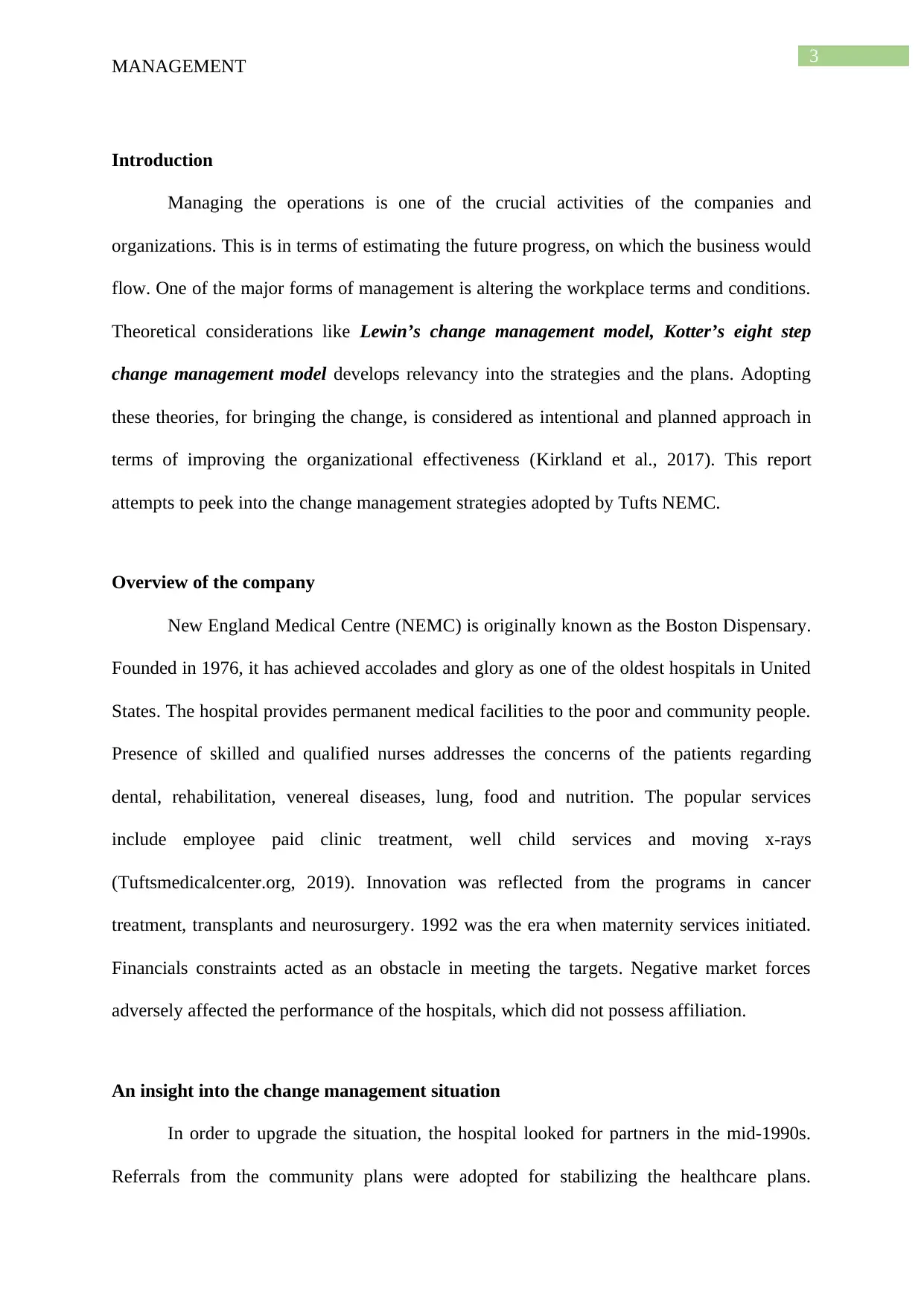
3
MANAGEMENT
Introduction
Managing the operations is one of the crucial activities of the companies and
organizations. This is in terms of estimating the future progress, on which the business would
flow. One of the major forms of management is altering the workplace terms and conditions.
Theoretical considerations like Lewin’s change management model, Kotter’s eight step
change management model develops relevancy into the strategies and the plans. Adopting
these theories, for bringing the change, is considered as intentional and planned approach in
terms of improving the organizational effectiveness (Kirkland et al., 2017). This report
attempts to peek into the change management strategies adopted by Tufts NEMC.
Overview of the company
New England Medical Centre (NEMC) is originally known as the Boston Dispensary.
Founded in 1976, it has achieved accolades and glory as one of the oldest hospitals in United
States. The hospital provides permanent medical facilities to the poor and community people.
Presence of skilled and qualified nurses addresses the concerns of the patients regarding
dental, rehabilitation, venereal diseases, lung, food and nutrition. The popular services
include employee paid clinic treatment, well child services and moving x-rays
(Tuftsmedicalcenter.org, 2019). Innovation was reflected from the programs in cancer
treatment, transplants and neurosurgery. 1992 was the era when maternity services initiated.
Financials constraints acted as an obstacle in meeting the targets. Negative market forces
adversely affected the performance of the hospitals, which did not possess affiliation.
An insight into the change management situation
In order to upgrade the situation, the hospital looked for partners in the mid-1990s.
Referrals from the community plans were adopted for stabilizing the healthcare plans.
MANAGEMENT
Introduction
Managing the operations is one of the crucial activities of the companies and
organizations. This is in terms of estimating the future progress, on which the business would
flow. One of the major forms of management is altering the workplace terms and conditions.
Theoretical considerations like Lewin’s change management model, Kotter’s eight step
change management model develops relevancy into the strategies and the plans. Adopting
these theories, for bringing the change, is considered as intentional and planned approach in
terms of improving the organizational effectiveness (Kirkland et al., 2017). This report
attempts to peek into the change management strategies adopted by Tufts NEMC.
Overview of the company
New England Medical Centre (NEMC) is originally known as the Boston Dispensary.
Founded in 1976, it has achieved accolades and glory as one of the oldest hospitals in United
States. The hospital provides permanent medical facilities to the poor and community people.
Presence of skilled and qualified nurses addresses the concerns of the patients regarding
dental, rehabilitation, venereal diseases, lung, food and nutrition. The popular services
include employee paid clinic treatment, well child services and moving x-rays
(Tuftsmedicalcenter.org, 2019). Innovation was reflected from the programs in cancer
treatment, transplants and neurosurgery. 1992 was the era when maternity services initiated.
Financials constraints acted as an obstacle in meeting the targets. Negative market forces
adversely affected the performance of the hospitals, which did not possess affiliation.
An insight into the change management situation
In order to upgrade the situation, the hospital looked for partners in the mid-1990s.
Referrals from the community plans were adopted for stabilizing the healthcare plans.
Paraphrase This Document
Need a fresh take? Get an instant paraphrase of this document with our AI Paraphraser
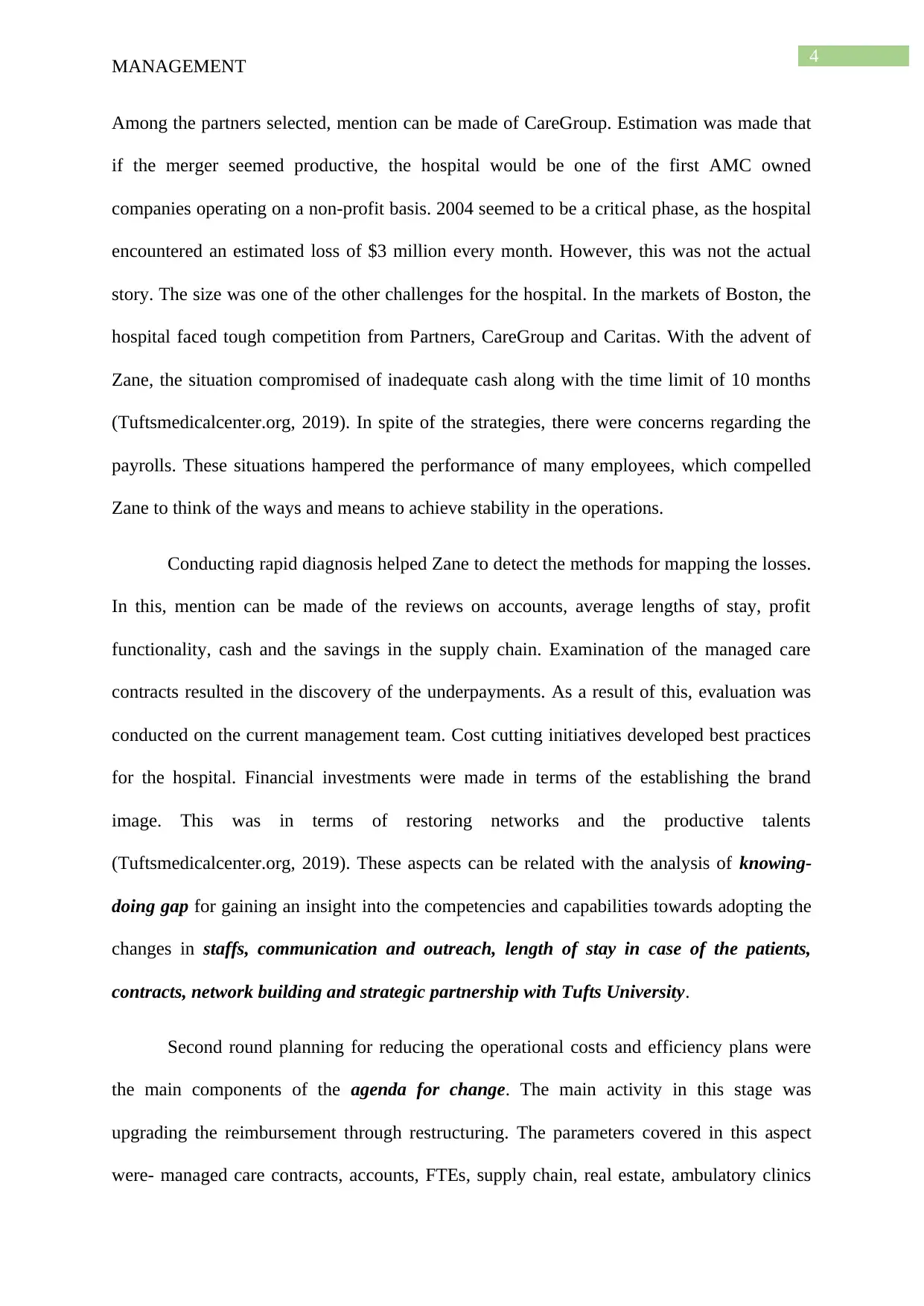
4
MANAGEMENT
Among the partners selected, mention can be made of CareGroup. Estimation was made that
if the merger seemed productive, the hospital would be one of the first AMC owned
companies operating on a non-profit basis. 2004 seemed to be a critical phase, as the hospital
encountered an estimated loss of $3 million every month. However, this was not the actual
story. The size was one of the other challenges for the hospital. In the markets of Boston, the
hospital faced tough competition from Partners, CareGroup and Caritas. With the advent of
Zane, the situation compromised of inadequate cash along with the time limit of 10 months
(Tuftsmedicalcenter.org, 2019). In spite of the strategies, there were concerns regarding the
payrolls. These situations hampered the performance of many employees, which compelled
Zane to think of the ways and means to achieve stability in the operations.
Conducting rapid diagnosis helped Zane to detect the methods for mapping the losses.
In this, mention can be made of the reviews on accounts, average lengths of stay, profit
functionality, cash and the savings in the supply chain. Examination of the managed care
contracts resulted in the discovery of the underpayments. As a result of this, evaluation was
conducted on the current management team. Cost cutting initiatives developed best practices
for the hospital. Financial investments were made in terms of the establishing the brand
image. This was in terms of restoring networks and the productive talents
(Tuftsmedicalcenter.org, 2019). These aspects can be related with the analysis of knowing-
doing gap for gaining an insight into the competencies and capabilities towards adopting the
changes in staffs, communication and outreach, length of stay in case of the patients,
contracts, network building and strategic partnership with Tufts University.
Second round planning for reducing the operational costs and efficiency plans were
the main components of the agenda for change. The main activity in this stage was
upgrading the reimbursement through restructuring. The parameters covered in this aspect
were- managed care contracts, accounts, FTEs, supply chain, real estate, ambulatory clinics
MANAGEMENT
Among the partners selected, mention can be made of CareGroup. Estimation was made that
if the merger seemed productive, the hospital would be one of the first AMC owned
companies operating on a non-profit basis. 2004 seemed to be a critical phase, as the hospital
encountered an estimated loss of $3 million every month. However, this was not the actual
story. The size was one of the other challenges for the hospital. In the markets of Boston, the
hospital faced tough competition from Partners, CareGroup and Caritas. With the advent of
Zane, the situation compromised of inadequate cash along with the time limit of 10 months
(Tuftsmedicalcenter.org, 2019). In spite of the strategies, there were concerns regarding the
payrolls. These situations hampered the performance of many employees, which compelled
Zane to think of the ways and means to achieve stability in the operations.
Conducting rapid diagnosis helped Zane to detect the methods for mapping the losses.
In this, mention can be made of the reviews on accounts, average lengths of stay, profit
functionality, cash and the savings in the supply chain. Examination of the managed care
contracts resulted in the discovery of the underpayments. As a result of this, evaluation was
conducted on the current management team. Cost cutting initiatives developed best practices
for the hospital. Financial investments were made in terms of the establishing the brand
image. This was in terms of restoring networks and the productive talents
(Tuftsmedicalcenter.org, 2019). These aspects can be related with the analysis of knowing-
doing gap for gaining an insight into the competencies and capabilities towards adopting the
changes in staffs, communication and outreach, length of stay in case of the patients,
contracts, network building and strategic partnership with Tufts University.
Second round planning for reducing the operational costs and efficiency plans were
the main components of the agenda for change. The main activity in this stage was
upgrading the reimbursement through restructuring. The parameters covered in this aspect
were- managed care contracts, accounts, FTEs, supply chain, real estate, ambulatory clinics
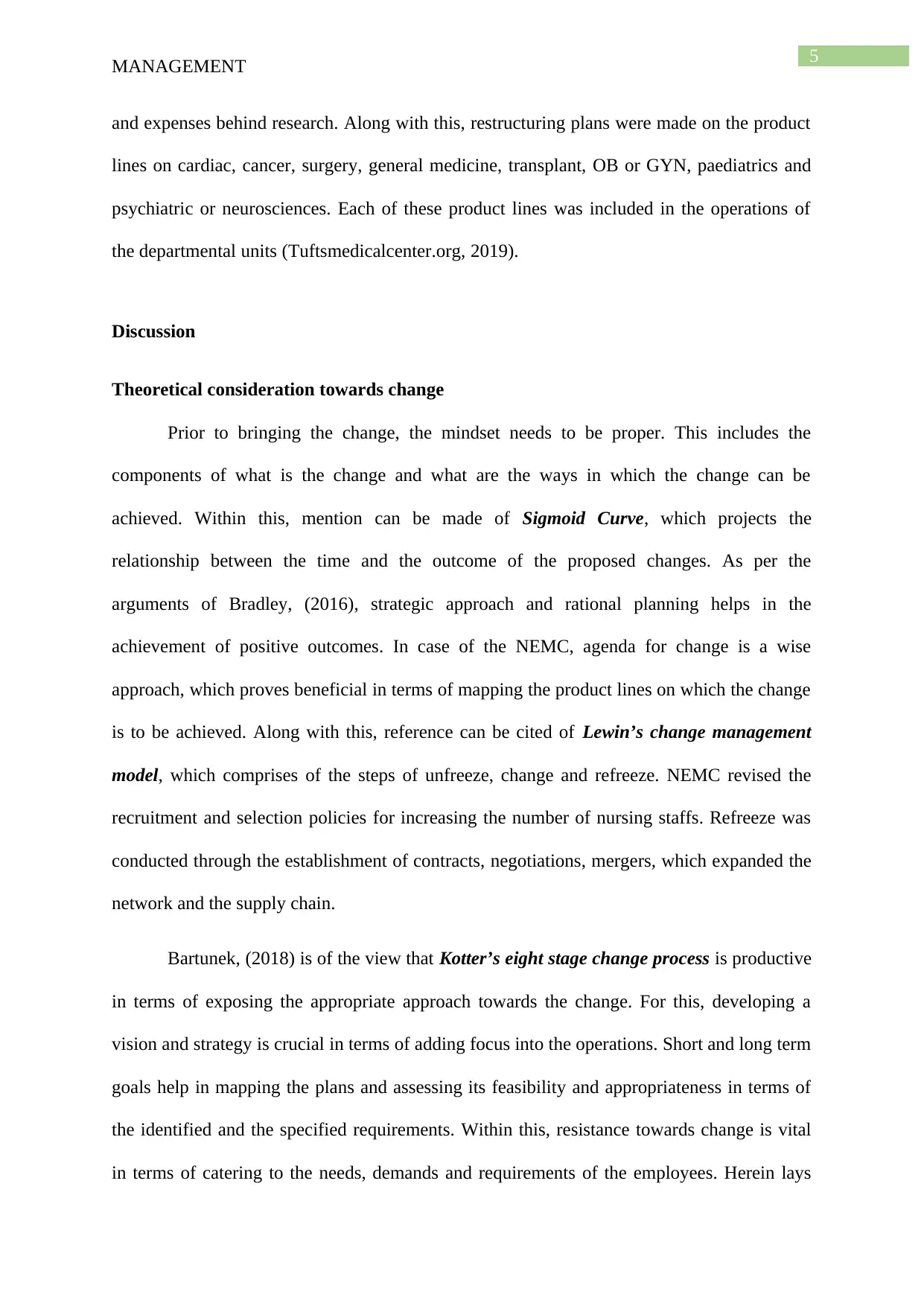
5
MANAGEMENT
and expenses behind research. Along with this, restructuring plans were made on the product
lines on cardiac, cancer, surgery, general medicine, transplant, OB or GYN, paediatrics and
psychiatric or neurosciences. Each of these product lines was included in the operations of
the departmental units (Tuftsmedicalcenter.org, 2019).
Discussion
Theoretical consideration towards change
Prior to bringing the change, the mindset needs to be proper. This includes the
components of what is the change and what are the ways in which the change can be
achieved. Within this, mention can be made of Sigmoid Curve, which projects the
relationship between the time and the outcome of the proposed changes. As per the
arguments of Bradley, (2016), strategic approach and rational planning helps in the
achievement of positive outcomes. In case of the NEMC, agenda for change is a wise
approach, which proves beneficial in terms of mapping the product lines on which the change
is to be achieved. Along with this, reference can be cited of Lewin’s change management
model, which comprises of the steps of unfreeze, change and refreeze. NEMC revised the
recruitment and selection policies for increasing the number of nursing staffs. Refreeze was
conducted through the establishment of contracts, negotiations, mergers, which expanded the
network and the supply chain.
Bartunek, (2018) is of the view that Kotter’s eight stage change process is productive
in terms of exposing the appropriate approach towards the change. For this, developing a
vision and strategy is crucial in terms of adding focus into the operations. Short and long term
goals help in mapping the plans and assessing its feasibility and appropriateness in terms of
the identified and the specified requirements. Within this, resistance towards change is vital
in terms of catering to the needs, demands and requirements of the employees. Herein lays
MANAGEMENT
and expenses behind research. Along with this, restructuring plans were made on the product
lines on cardiac, cancer, surgery, general medicine, transplant, OB or GYN, paediatrics and
psychiatric or neurosciences. Each of these product lines was included in the operations of
the departmental units (Tuftsmedicalcenter.org, 2019).
Discussion
Theoretical consideration towards change
Prior to bringing the change, the mindset needs to be proper. This includes the
components of what is the change and what are the ways in which the change can be
achieved. Within this, mention can be made of Sigmoid Curve, which projects the
relationship between the time and the outcome of the proposed changes. As per the
arguments of Bradley, (2016), strategic approach and rational planning helps in the
achievement of positive outcomes. In case of the NEMC, agenda for change is a wise
approach, which proves beneficial in terms of mapping the product lines on which the change
is to be achieved. Along with this, reference can be cited of Lewin’s change management
model, which comprises of the steps of unfreeze, change and refreeze. NEMC revised the
recruitment and selection policies for increasing the number of nursing staffs. Refreeze was
conducted through the establishment of contracts, negotiations, mergers, which expanded the
network and the supply chain.
Bartunek, (2018) is of the view that Kotter’s eight stage change process is productive
in terms of exposing the appropriate approach towards the change. For this, developing a
vision and strategy is crucial in terms of adding focus into the operations. Short and long term
goals help in mapping the plans and assessing its feasibility and appropriateness in terms of
the identified and the specified requirements. Within this, resistance towards change is vital
in terms of catering to the needs, demands and requirements of the employees. Herein lays
⊘ This is a preview!⊘
Do you want full access?
Subscribe today to unlock all pages.

Trusted by 1+ million students worldwide
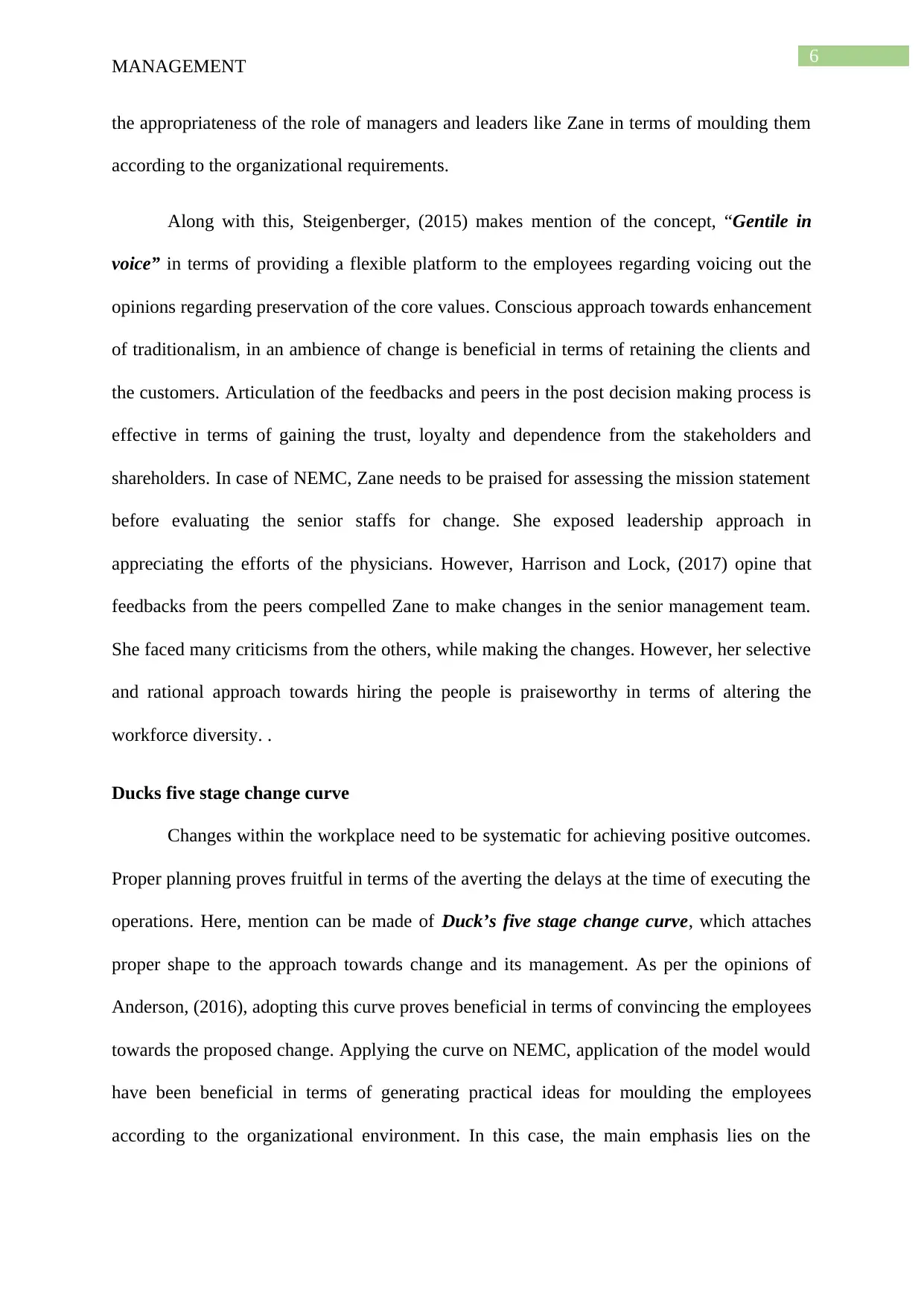
6
MANAGEMENT
the appropriateness of the role of managers and leaders like Zane in terms of moulding them
according to the organizational requirements.
Along with this, Steigenberger, (2015) makes mention of the concept, “Gentile in
voice” in terms of providing a flexible platform to the employees regarding voicing out the
opinions regarding preservation of the core values. Conscious approach towards enhancement
of traditionalism, in an ambience of change is beneficial in terms of retaining the clients and
the customers. Articulation of the feedbacks and peers in the post decision making process is
effective in terms of gaining the trust, loyalty and dependence from the stakeholders and
shareholders. In case of NEMC, Zane needs to be praised for assessing the mission statement
before evaluating the senior staffs for change. She exposed leadership approach in
appreciating the efforts of the physicians. However, Harrison and Lock, (2017) opine that
feedbacks from the peers compelled Zane to make changes in the senior management team.
She faced many criticisms from the others, while making the changes. However, her selective
and rational approach towards hiring the people is praiseworthy in terms of altering the
workforce diversity. .
Ducks five stage change curve
Changes within the workplace need to be systematic for achieving positive outcomes.
Proper planning proves fruitful in terms of the averting the delays at the time of executing the
operations. Here, mention can be made of Duck’s five stage change curve, which attaches
proper shape to the approach towards change and its management. As per the opinions of
Anderson, (2016), adopting this curve proves beneficial in terms of convincing the employees
towards the proposed change. Applying the curve on NEMC, application of the model would
have been beneficial in terms of generating practical ideas for moulding the employees
according to the organizational environment. In this case, the main emphasis lies on the
MANAGEMENT
the appropriateness of the role of managers and leaders like Zane in terms of moulding them
according to the organizational requirements.
Along with this, Steigenberger, (2015) makes mention of the concept, “Gentile in
voice” in terms of providing a flexible platform to the employees regarding voicing out the
opinions regarding preservation of the core values. Conscious approach towards enhancement
of traditionalism, in an ambience of change is beneficial in terms of retaining the clients and
the customers. Articulation of the feedbacks and peers in the post decision making process is
effective in terms of gaining the trust, loyalty and dependence from the stakeholders and
shareholders. In case of NEMC, Zane needs to be praised for assessing the mission statement
before evaluating the senior staffs for change. She exposed leadership approach in
appreciating the efforts of the physicians. However, Harrison and Lock, (2017) opine that
feedbacks from the peers compelled Zane to make changes in the senior management team.
She faced many criticisms from the others, while making the changes. However, her selective
and rational approach towards hiring the people is praiseworthy in terms of altering the
workforce diversity. .
Ducks five stage change curve
Changes within the workplace need to be systematic for achieving positive outcomes.
Proper planning proves fruitful in terms of the averting the delays at the time of executing the
operations. Here, mention can be made of Duck’s five stage change curve, which attaches
proper shape to the approach towards change and its management. As per the opinions of
Anderson, (2016), adopting this curve proves beneficial in terms of convincing the employees
towards the proposed change. Applying the curve on NEMC, application of the model would
have been beneficial in terms of generating practical ideas for moulding the employees
according to the organizational environment. In this case, the main emphasis lies on the
Paraphrase This Document
Need a fresh take? Get an instant paraphrase of this document with our AI Paraphraser
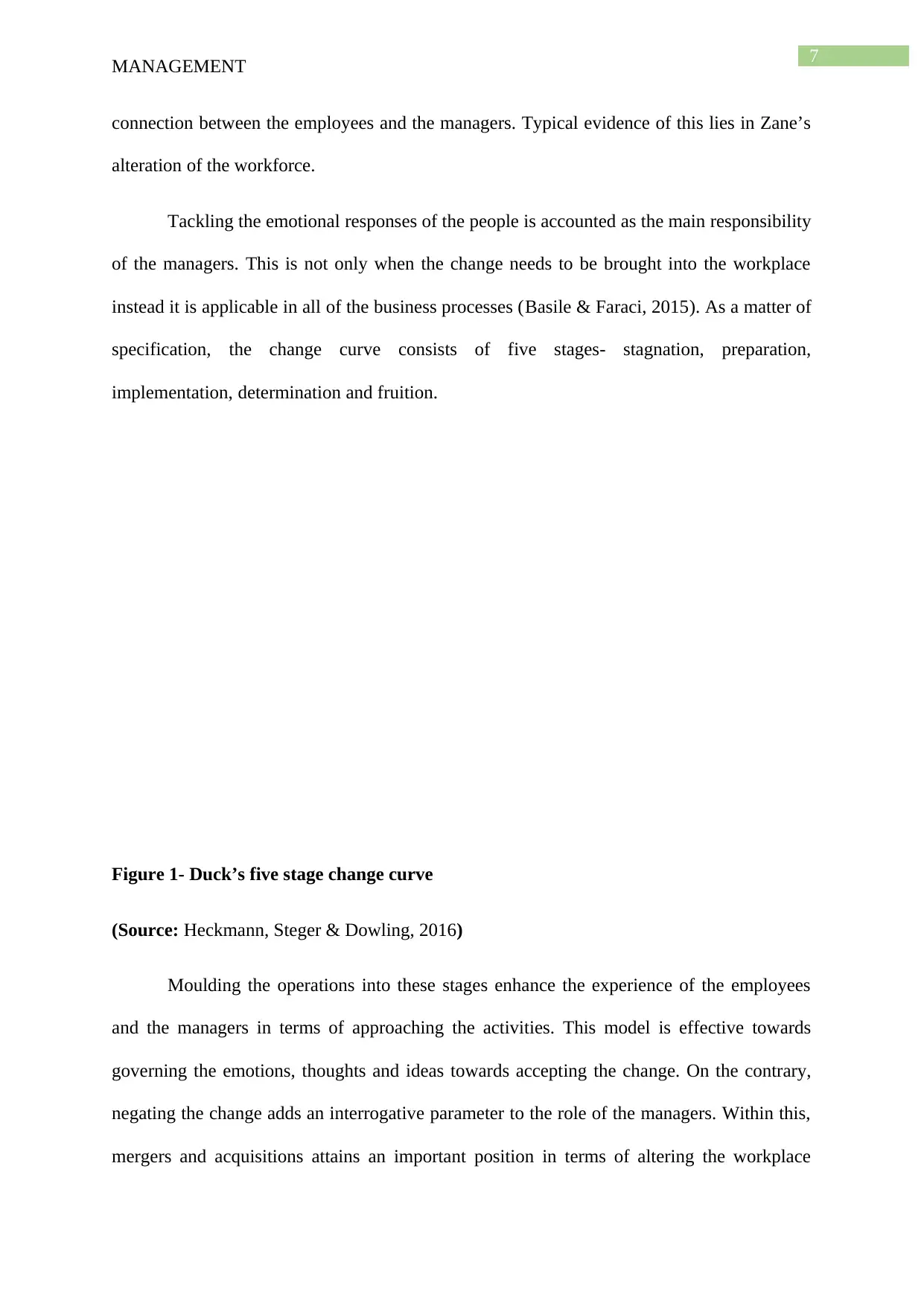
7
MANAGEMENT
connection between the employees and the managers. Typical evidence of this lies in Zane’s
alteration of the workforce.
Tackling the emotional responses of the people is accounted as the main responsibility
of the managers. This is not only when the change needs to be brought into the workplace
instead it is applicable in all of the business processes (Basile & Faraci, 2015). As a matter of
specification, the change curve consists of five stages- stagnation, preparation,
implementation, determination and fruition.
Figure 1- Duck’s five stage change curve
(Source: Heckmann, Steger & Dowling, 2016)
Moulding the operations into these stages enhance the experience of the employees
and the managers in terms of approaching the activities. This model is effective towards
governing the emotions, thoughts and ideas towards accepting the change. On the contrary,
negating the change adds an interrogative parameter to the role of the managers. Within this,
mergers and acquisitions attains an important position in terms of altering the workplace
MANAGEMENT
connection between the employees and the managers. Typical evidence of this lies in Zane’s
alteration of the workforce.
Tackling the emotional responses of the people is accounted as the main responsibility
of the managers. This is not only when the change needs to be brought into the workplace
instead it is applicable in all of the business processes (Basile & Faraci, 2015). As a matter of
specification, the change curve consists of five stages- stagnation, preparation,
implementation, determination and fruition.
Figure 1- Duck’s five stage change curve
(Source: Heckmann, Steger & Dowling, 2016)
Moulding the operations into these stages enhance the experience of the employees
and the managers in terms of approaching the activities. This model is effective towards
governing the emotions, thoughts and ideas towards accepting the change. On the contrary,
negating the change adds an interrogative parameter to the role of the managers. Within this,
mergers and acquisitions attains an important position in terms of altering the workplace
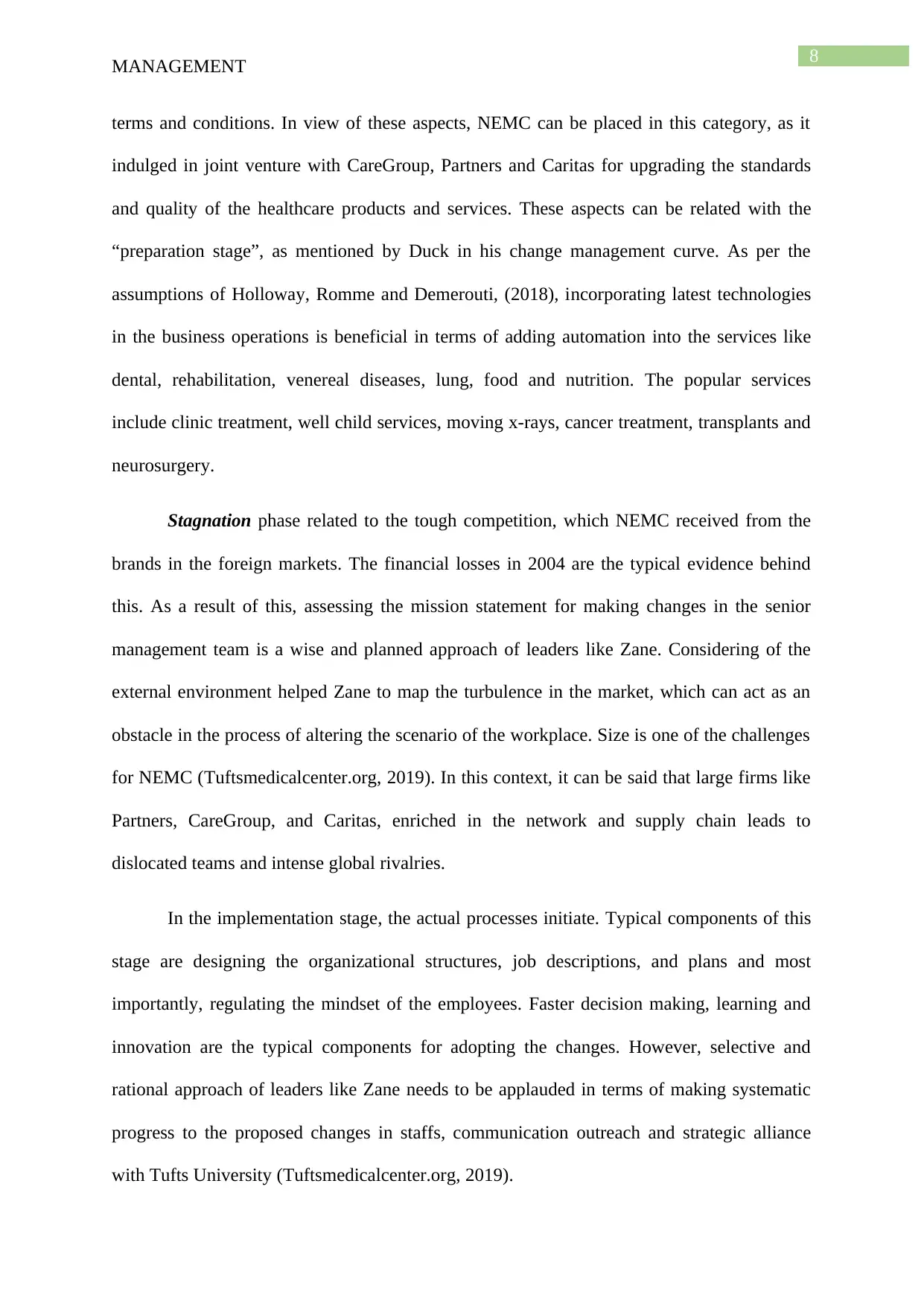
8
MANAGEMENT
terms and conditions. In view of these aspects, NEMC can be placed in this category, as it
indulged in joint venture with CareGroup, Partners and Caritas for upgrading the standards
and quality of the healthcare products and services. These aspects can be related with the
“preparation stage”, as mentioned by Duck in his change management curve. As per the
assumptions of Holloway, Romme and Demerouti, (2018), incorporating latest technologies
in the business operations is beneficial in terms of adding automation into the services like
dental, rehabilitation, venereal diseases, lung, food and nutrition. The popular services
include clinic treatment, well child services, moving x-rays, cancer treatment, transplants and
neurosurgery.
Stagnation phase related to the tough competition, which NEMC received from the
brands in the foreign markets. The financial losses in 2004 are the typical evidence behind
this. As a result of this, assessing the mission statement for making changes in the senior
management team is a wise and planned approach of leaders like Zane. Considering of the
external environment helped Zane to map the turbulence in the market, which can act as an
obstacle in the process of altering the scenario of the workplace. Size is one of the challenges
for NEMC (Tuftsmedicalcenter.org, 2019). In this context, it can be said that large firms like
Partners, CareGroup, and Caritas, enriched in the network and supply chain leads to
dislocated teams and intense global rivalries.
In the implementation stage, the actual processes initiate. Typical components of this
stage are designing the organizational structures, job descriptions, and plans and most
importantly, regulating the mindset of the employees. Faster decision making, learning and
innovation are the typical components for adopting the changes. However, selective and
rational approach of leaders like Zane needs to be applauded in terms of making systematic
progress to the proposed changes in staffs, communication outreach and strategic alliance
with Tufts University (Tuftsmedicalcenter.org, 2019).
MANAGEMENT
terms and conditions. In view of these aspects, NEMC can be placed in this category, as it
indulged in joint venture with CareGroup, Partners and Caritas for upgrading the standards
and quality of the healthcare products and services. These aspects can be related with the
“preparation stage”, as mentioned by Duck in his change management curve. As per the
assumptions of Holloway, Romme and Demerouti, (2018), incorporating latest technologies
in the business operations is beneficial in terms of adding automation into the services like
dental, rehabilitation, venereal diseases, lung, food and nutrition. The popular services
include clinic treatment, well child services, moving x-rays, cancer treatment, transplants and
neurosurgery.
Stagnation phase related to the tough competition, which NEMC received from the
brands in the foreign markets. The financial losses in 2004 are the typical evidence behind
this. As a result of this, assessing the mission statement for making changes in the senior
management team is a wise and planned approach of leaders like Zane. Considering of the
external environment helped Zane to map the turbulence in the market, which can act as an
obstacle in the process of altering the scenario of the workplace. Size is one of the challenges
for NEMC (Tuftsmedicalcenter.org, 2019). In this context, it can be said that large firms like
Partners, CareGroup, and Caritas, enriched in the network and supply chain leads to
dislocated teams and intense global rivalries.
In the implementation stage, the actual processes initiate. Typical components of this
stage are designing the organizational structures, job descriptions, and plans and most
importantly, regulating the mindset of the employees. Faster decision making, learning and
innovation are the typical components for adopting the changes. However, selective and
rational approach of leaders like Zane needs to be applauded in terms of making systematic
progress to the proposed changes in staffs, communication outreach and strategic alliance
with Tufts University (Tuftsmedicalcenter.org, 2019).
⊘ This is a preview!⊘
Do you want full access?
Subscribe today to unlock all pages.

Trusted by 1+ million students worldwide
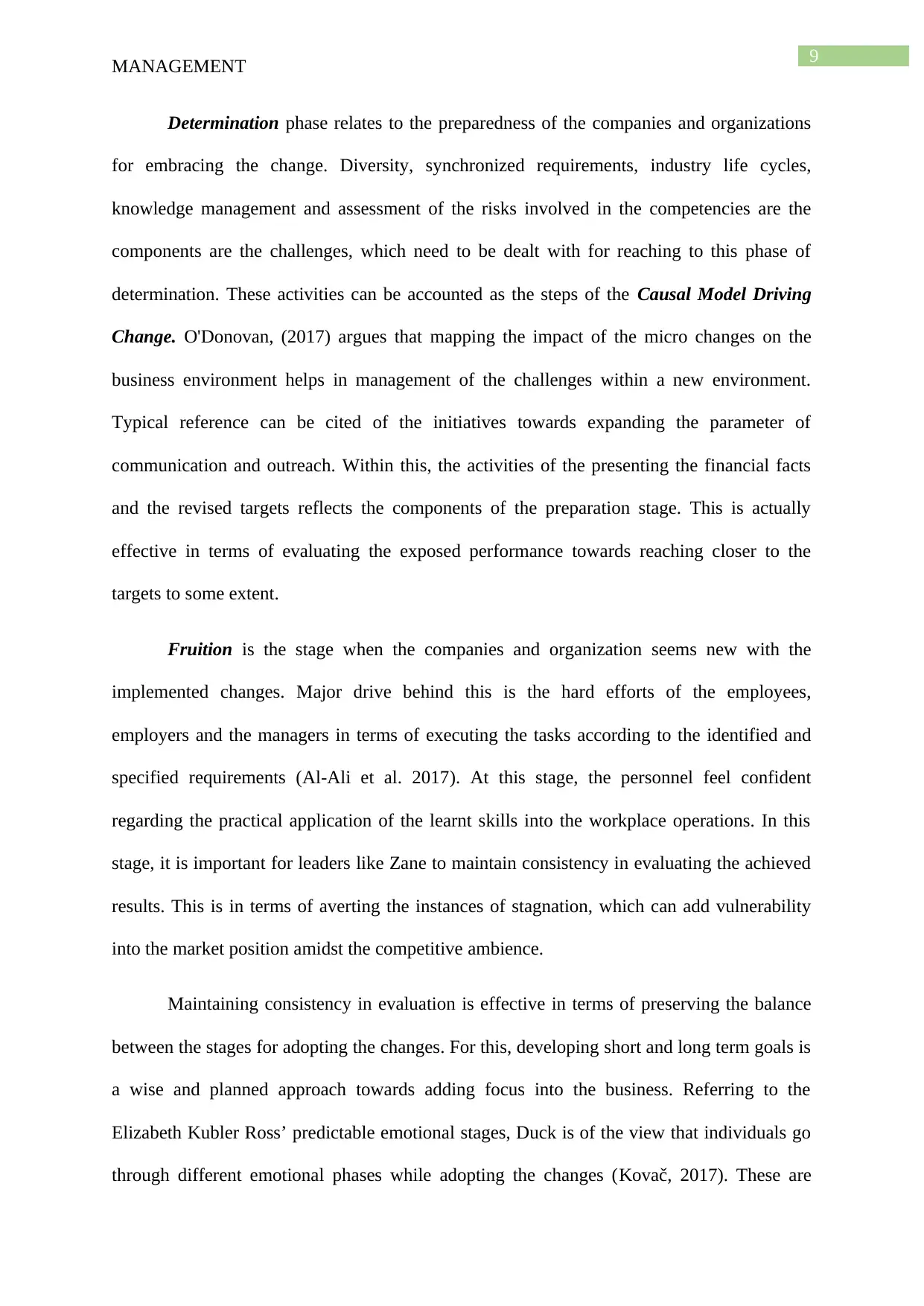
9
MANAGEMENT
Determination phase relates to the preparedness of the companies and organizations
for embracing the change. Diversity, synchronized requirements, industry life cycles,
knowledge management and assessment of the risks involved in the competencies are the
components are the challenges, which need to be dealt with for reaching to this phase of
determination. These activities can be accounted as the steps of the Causal Model Driving
Change. O'Donovan, (2017) argues that mapping the impact of the micro changes on the
business environment helps in management of the challenges within a new environment.
Typical reference can be cited of the initiatives towards expanding the parameter of
communication and outreach. Within this, the activities of the presenting the financial facts
and the revised targets reflects the components of the preparation stage. This is actually
effective in terms of evaluating the exposed performance towards reaching closer to the
targets to some extent.
Fruition is the stage when the companies and organization seems new with the
implemented changes. Major drive behind this is the hard efforts of the employees,
employers and the managers in terms of executing the tasks according to the identified and
specified requirements (Al-Ali et al. 2017). At this stage, the personnel feel confident
regarding the practical application of the learnt skills into the workplace operations. In this
stage, it is important for leaders like Zane to maintain consistency in evaluating the achieved
results. This is in terms of averting the instances of stagnation, which can add vulnerability
into the market position amidst the competitive ambience.
Maintaining consistency in evaluation is effective in terms of preserving the balance
between the stages for adopting the changes. For this, developing short and long term goals is
a wise and planned approach towards adding focus into the business. Referring to the
Elizabeth Kubler Ross’ predictable emotional stages, Duck is of the view that individuals go
through different emotional phases while adopting the changes (Kovač, 2017). These are
MANAGEMENT
Determination phase relates to the preparedness of the companies and organizations
for embracing the change. Diversity, synchronized requirements, industry life cycles,
knowledge management and assessment of the risks involved in the competencies are the
components are the challenges, which need to be dealt with for reaching to this phase of
determination. These activities can be accounted as the steps of the Causal Model Driving
Change. O'Donovan, (2017) argues that mapping the impact of the micro changes on the
business environment helps in management of the challenges within a new environment.
Typical reference can be cited of the initiatives towards expanding the parameter of
communication and outreach. Within this, the activities of the presenting the financial facts
and the revised targets reflects the components of the preparation stage. This is actually
effective in terms of evaluating the exposed performance towards reaching closer to the
targets to some extent.
Fruition is the stage when the companies and organization seems new with the
implemented changes. Major drive behind this is the hard efforts of the employees,
employers and the managers in terms of executing the tasks according to the identified and
specified requirements (Al-Ali et al. 2017). At this stage, the personnel feel confident
regarding the practical application of the learnt skills into the workplace operations. In this
stage, it is important for leaders like Zane to maintain consistency in evaluating the achieved
results. This is in terms of averting the instances of stagnation, which can add vulnerability
into the market position amidst the competitive ambience.
Maintaining consistency in evaluation is effective in terms of preserving the balance
between the stages for adopting the changes. For this, developing short and long term goals is
a wise and planned approach towards adding focus into the business. Referring to the
Elizabeth Kubler Ross’ predictable emotional stages, Duck is of the view that individuals go
through different emotional phases while adopting the changes (Kovač, 2017). These are
Paraphrase This Document
Need a fresh take? Get an instant paraphrase of this document with our AI Paraphraser
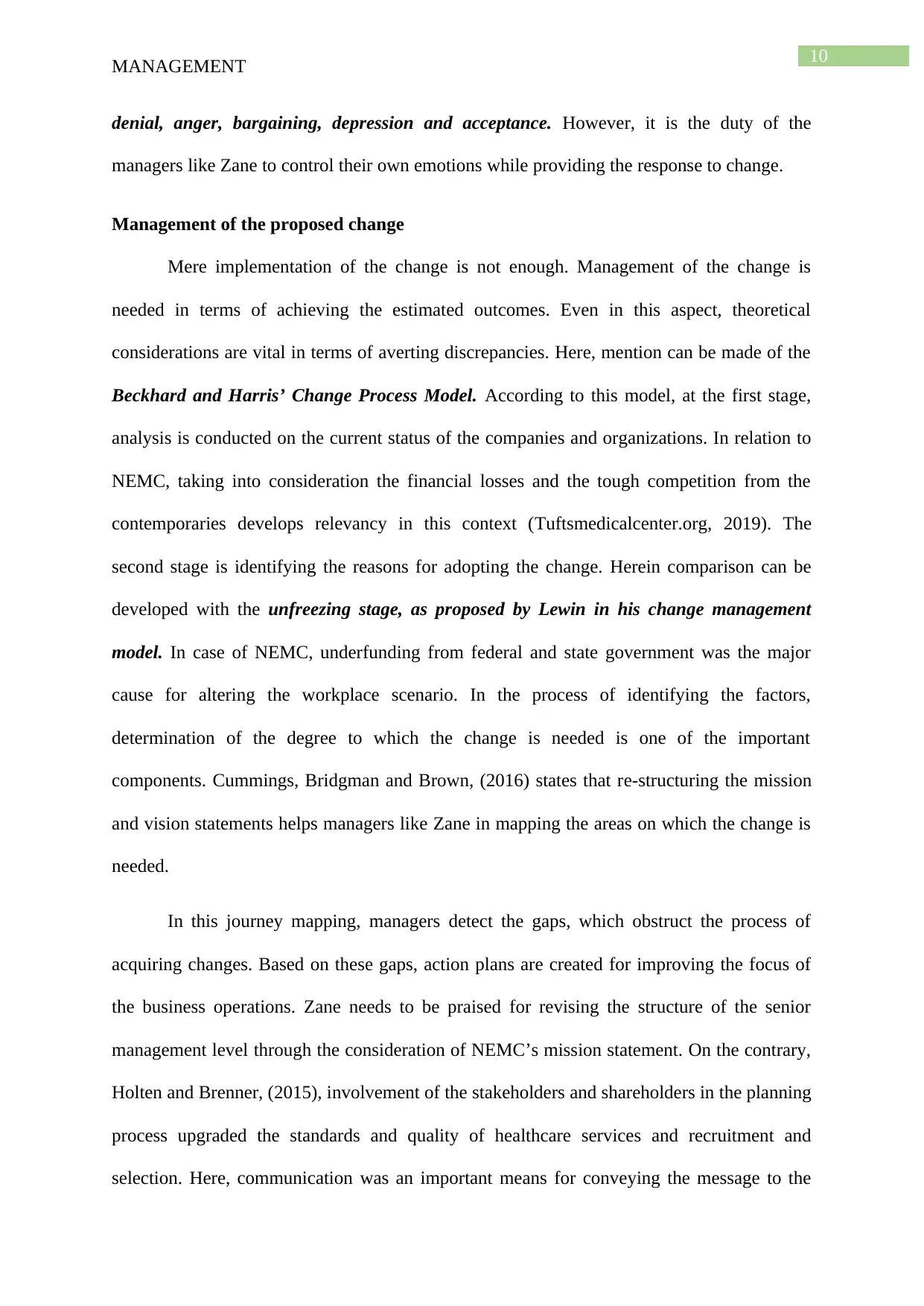
10
MANAGEMENT
denial, anger, bargaining, depression and acceptance. However, it is the duty of the
managers like Zane to control their own emotions while providing the response to change.
Management of the proposed change
Mere implementation of the change is not enough. Management of the change is
needed in terms of achieving the estimated outcomes. Even in this aspect, theoretical
considerations are vital in terms of averting discrepancies. Here, mention can be made of the
Beckhard and Harris’ Change Process Model. According to this model, at the first stage,
analysis is conducted on the current status of the companies and organizations. In relation to
NEMC, taking into consideration the financial losses and the tough competition from the
contemporaries develops relevancy in this context (Tuftsmedicalcenter.org, 2019). The
second stage is identifying the reasons for adopting the change. Herein comparison can be
developed with the unfreezing stage, as proposed by Lewin in his change management
model. In case of NEMC, underfunding from federal and state government was the major
cause for altering the workplace scenario. In the process of identifying the factors,
determination of the degree to which the change is needed is one of the important
components. Cummings, Bridgman and Brown, (2016) states that re-structuring the mission
and vision statements helps managers like Zane in mapping the areas on which the change is
needed.
In this journey mapping, managers detect the gaps, which obstruct the process of
acquiring changes. Based on these gaps, action plans are created for improving the focus of
the business operations. Zane needs to be praised for revising the structure of the senior
management level through the consideration of NEMC’s mission statement. On the contrary,
Holten and Brenner, (2015), involvement of the stakeholders and shareholders in the planning
process upgraded the standards and quality of healthcare services and recruitment and
selection. Here, communication was an important means for conveying the message to the
MANAGEMENT
denial, anger, bargaining, depression and acceptance. However, it is the duty of the
managers like Zane to control their own emotions while providing the response to change.
Management of the proposed change
Mere implementation of the change is not enough. Management of the change is
needed in terms of achieving the estimated outcomes. Even in this aspect, theoretical
considerations are vital in terms of averting discrepancies. Here, mention can be made of the
Beckhard and Harris’ Change Process Model. According to this model, at the first stage,
analysis is conducted on the current status of the companies and organizations. In relation to
NEMC, taking into consideration the financial losses and the tough competition from the
contemporaries develops relevancy in this context (Tuftsmedicalcenter.org, 2019). The
second stage is identifying the reasons for adopting the change. Herein comparison can be
developed with the unfreezing stage, as proposed by Lewin in his change management
model. In case of NEMC, underfunding from federal and state government was the major
cause for altering the workplace scenario. In the process of identifying the factors,
determination of the degree to which the change is needed is one of the important
components. Cummings, Bridgman and Brown, (2016) states that re-structuring the mission
and vision statements helps managers like Zane in mapping the areas on which the change is
needed.
In this journey mapping, managers detect the gaps, which obstruct the process of
acquiring changes. Based on these gaps, action plans are created for improving the focus of
the business operations. Zane needs to be praised for revising the structure of the senior
management level through the consideration of NEMC’s mission statement. On the contrary,
Holten and Brenner, (2015), involvement of the stakeholders and shareholders in the planning
process upgraded the standards and quality of healthcare services and recruitment and
selection. Here, communication was an important means for conveying the message to the
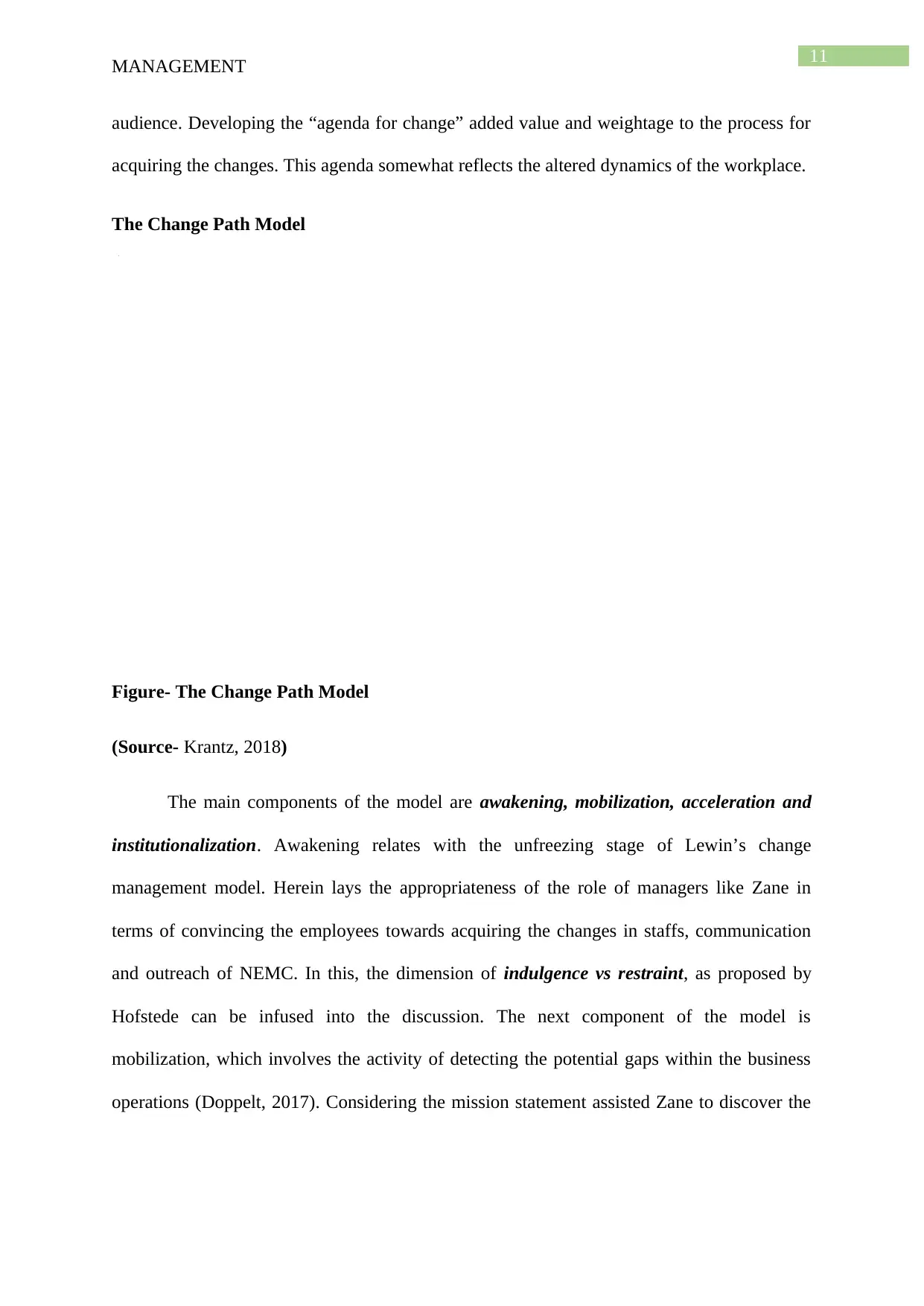
11
MANAGEMENT
audience. Developing the “agenda for change” added value and weightage to the process for
acquiring the changes. This agenda somewhat reflects the altered dynamics of the workplace.
The Change Path Model
Figure- The Change Path Model
(Source- Krantz, 2018)
The main components of the model are awakening, mobilization, acceleration and
institutionalization. Awakening relates with the unfreezing stage of Lewin’s change
management model. Herein lays the appropriateness of the role of managers like Zane in
terms of convincing the employees towards acquiring the changes in staffs, communication
and outreach of NEMC. In this, the dimension of indulgence vs restraint, as proposed by
Hofstede can be infused into the discussion. The next component of the model is
mobilization, which involves the activity of detecting the potential gaps within the business
operations (Doppelt, 2017). Considering the mission statement assisted Zane to discover the
MANAGEMENT
audience. Developing the “agenda for change” added value and weightage to the process for
acquiring the changes. This agenda somewhat reflects the altered dynamics of the workplace.
The Change Path Model
Figure- The Change Path Model
(Source- Krantz, 2018)
The main components of the model are awakening, mobilization, acceleration and
institutionalization. Awakening relates with the unfreezing stage of Lewin’s change
management model. Herein lays the appropriateness of the role of managers like Zane in
terms of convincing the employees towards acquiring the changes in staffs, communication
and outreach of NEMC. In this, the dimension of indulgence vs restraint, as proposed by
Hofstede can be infused into the discussion. The next component of the model is
mobilization, which involves the activity of detecting the potential gaps within the business
operations (Doppelt, 2017). Considering the mission statement assisted Zane to discover the
⊘ This is a preview!⊘
Do you want full access?
Subscribe today to unlock all pages.

Trusted by 1+ million students worldwide
1 out of 21
Your All-in-One AI-Powered Toolkit for Academic Success.
+13062052269
info@desklib.com
Available 24*7 on WhatsApp / Email
![[object Object]](/_next/static/media/star-bottom.7253800d.svg)
Unlock your academic potential
Copyright © 2020–2025 A2Z Services. All Rights Reserved. Developed and managed by ZUCOL.

